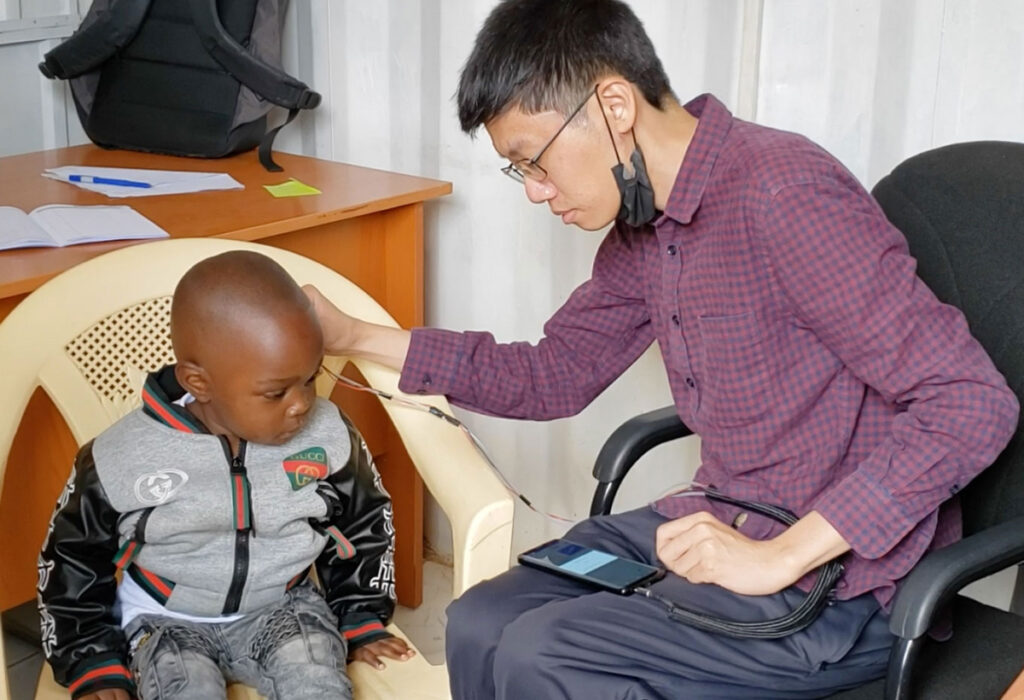
If you’re a frequent flyer, you may have amassed a motley collection of complimentary airline earbuds over the course of your travels — if you didn’t toss them in the trash immediately after clearing customs, that is. Soon, those throwaway pieces of plastic and wire could potentially transform the lives of children around the world. A team that includes Allen School professor Shyam Gollakota and Ph.D. student Justin Chan has devised a way to repurpose inexpensive earbuds to turn any smartphone into a device for screening newborn babies for hearing loss. The team described its prototype system in a paper published today in Nature Biomedical Engineering.
Clinicians screen newborns’ hearing by stimulating and evaluating otoacoustic emissions, or OAE, which are the sounds generated by the movement of the outer hair cells of a healthy cochlea. While such screening is currently routine in the United States, in many countries hospitals and clinics cannot afford the specialized equipment for administering the test. That disparity, along with firsthand experience, motivated Gollakota to tackle the project.
“I grew up in a country where there was no hearing screening available, in part because the screening device itself is pretty expensive,” Gollakota, who holds the Washington Research Foundation / Thomas J. Cable Professorship in the Allen School, told UW News. “The project here is to leverage the ubiquity of mobile devices people across the world already have — smartphones and $2 to $3 earbuds — to make newborn hearing screening something that’s accessible to all without sacrificing quality.”
The team designed an inexpensive probe using the aforementioned earbuds, an off-the-shelf microphone and a length of lightweight silicon tubing. The system plays a different tone through each earbud to stimulate the cochlea, and then records the OAE via the attached microphone and transmits it through the smartphone’s headphone jack for processing. In clinical testing involving more than 100 patients, the UW-developed system performed as well as commercial equipment costing thousands of dollars.
Now that they have a prototype, the researchers’ next step is to partner with local experts to scale up their approach. The team has already made a start by partnering with the UW Department of Global Health, the University of Nairobi and the Kenya Ministry of Health on the TUNE project, short for Toward Universal Newborn and Early Childhood Hearing Screening in Kenya. As reported on TUNE’s website, in countries with routine newborn screening programs, doctors detect hearing impairments in babies by the time they are two to three months of age; in countries without such programs, hearing loss often is not detected until the child reaches three years of age.
“We have an opportunity to really have an impact on global health, especially for newborn hearing,” Chan said. “I think it’s pretty gratifying to know that the research we do can help to directly solve real problems.”
Chan and Gollakota’s co-authors include Dr. Randall Bly and Dr. Emily Gallagher, both affiliated with UW Medicine and Seattle Children’s; Dr. Nada Ali of UW Medicine; Ali Najafi, who earned his Ph.D. from the UW Department of Electrical & Computer Engineering; Anna Meehan of Seattle Children’s, and Lisa Mancl of the UW Department of Speech & Hearing Sciences.
Read the Nature Biomedical Engineering paper here, a related article here, and the UW News release here.

